Polka-dot Batfish
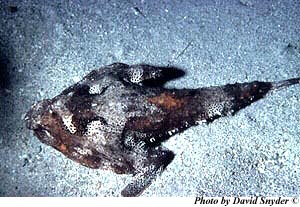
Ogcocephalus cubifrons
The batfish is an odd looking blobby, bumpy arrow-shaped fish with wide-set pectoral fins on ‘arms’ and small, forward placed pelvic fins underneath its body. It tends to move sluggishly around the sand and rubble bottom or among the seagrass, scavenging for small crabs, shrimps, molluscs, worms or other slow-moving small prey. When approached by a larger predator it flattens its wide, squat body to the floor, or in panic, will flee using its fins as legs to scurry into a better hiding spot.
Order – Perciformes
Family – Ogcocephalidae
Genus – Ogcocephalus
Species – cubifrons
Common Names
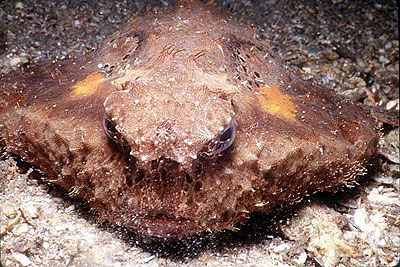
Common names referring to this species are polka dot batfish (English) and murciélago diablo (Spanish).
Importance to Humans
When approached by a diver, the polka-dot batfish will freeze, sometimes covering itself with sand, unless it is touched. The batfish will then attempt to flee, often scurrying across the bottom in the manner of a crab.
Conservation
The polka-dot batfish is not listed as endangered or vulnerable with the World Conservation Union (IUCN). The IUCN is a global union of states, governmental agencies, and non-governmental organizations in a partnership that assesses the conservation status of species.
> Check the status of the polka-dot batfish at the IUCN website.
Geographical Distribution
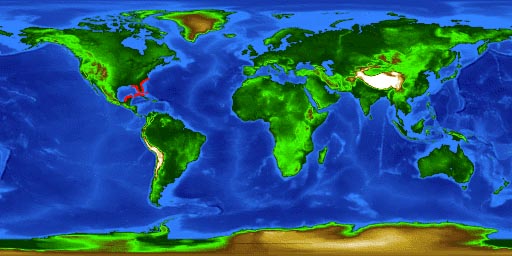
This batfish ranges along the western Atlantic coast from North Carolina to the panhandle of Florida. It also inhabits the northern Bahamas and is found on Campeche Bank, Mexico.
Habitat
The polka-dot batfish is a benthic species, found over sandy bottoms, seagrass beds, mud, and coral rubble. The depth that this fish inhabits ranges from the shoreline to as deep as 230 feet (70 m).
Biology
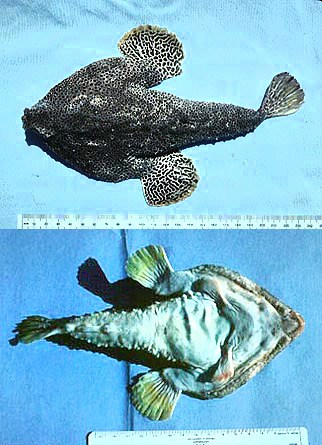
Distinctive Features
The polka-dot batfish, Ogcocephalus cubifrons, is one of the strangest looking fish in the sea. It is broad and flattened ventrally and shaped almost like an arrow. Its pelvic fins are situated underneath the body in front of the pectoral fins. The pectoral fins are quite flexible and situated on arm-like stalks. The batfish uses these fins to “walk” along the bottom. Tubercles cover the upper surface of the body, making it appear as if the fish is covered by warts. Batfishes do not have scales. The skin is rough with bony tubercles on the upper surface if the body and both surfaces of the tail. The polka-dot batfish may be confused with the short-nose batfish (Ogcocephalus nasutus), another batfish species in the area. An easy way to tell the two apart is to look at the pectoral fins: the polka-dot batfish has a pattern of dark spots on a lighter background while the shortnose has plain fins.
Coloration
The polka-dot batfish is, as its vernacular name suggests, covered by spots. Coloration is variable, but the fish usually is brownish in color, with dark round spots that are sometimes edged in white. There are reddish or yellowish orange patches scattered on the top of the body. The dark body and the color pattern of the polka-dot batfish serve as camouflage from predators and potential prey.
Dentition
Its teeth are conical, arranged in bands in the jaws, and in broad plates on the tongue.
Size, Age, and Growth
The polka dot batfish can reach up to 15 inches (38 cm).
Food Habits
The polka-dot batfish is a sluggish species, clearly not designed for speed or for chasing its prey all about the bottom. It makes up for this with unique adaptations to its rostrum and dorsal fin. The rostrum, a unicorn-like projection between the eyes, is quite long and pronounced in younger polka-dot batfish. As the fish ages, the rostrum gradually becomes shorter relative to the body size. The dorsal fin is modified into a single spine located underneath the rostrum. This spine is moveable and acts as a lure to attract prey within striking distance. The batfish feeds on small crabs, shrimps, molluscs, worms, and juvenile fish.
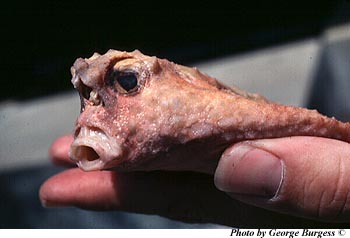
Parasites
The polka-dot batfish is often full of nematodes, parasitic worm-like creatures. It is a mystery why these creatures are often infested. Most likely it gets these parasites from the food it eats. The batfish may play a significant part in the nematode’s life cycle.
Taxonomy
The polka-dot batfish was first described as Lophius cubifrons by Richardson in 1836. This name was later changed to Malthaea cubifrons and then to the currently valid Ogcocephalus cubifrons (Richardson 1836). The genus name Ogcocephalus is derived from the Greek “ogkos, ou” meaning hook, curvature. There are no known synonyms in past scientific literature referring to this species.
Prepared by: Casey Patton